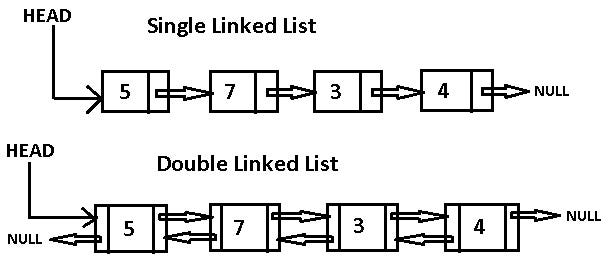Linked Lists - Data Structures In Real World
- 10 mins
Overview
When you first start diving into data structures, a lot of the discussions/reading tend to be abstract or even academic. While it can be good to learn these concepts in isolation, adding some real world context can help give a fuller picture of the purpose a data structures can serve.
My Experience with Applying Data Structures
Recently, when building a music streaming application, I had the opportunity to apply real-world context to a data structure. I was able to implement a modified double-linked list as the data structure for my playlist.
What is a Linked List?
A linked list is a sequence data structure, which connects elements, called nodes, through links. Unlike an array data structure, a node in a linked list isn’t necessarily positioned close to the previous element or the next element. Nodes in a linked list are connected by pointers. Linked lists are null terminating, which means whenever the pointer to the next node is null, the list has reached the end.
Single Linked List
 In single linked list, element or nodes only link to the next element in the list. A single linked list is null terminating meaning when the pointer is null, the list is finished.
In single linked list, element or nodes only link to the next element in the list. A single linked list is null terminating meaning when the pointer is null, the list is finished.
Double Linked List
 In a double linked list, each node contains a reference to the previous node and the next node (as long as they aren’t the head or tail node.) Each node has a value property.
In a double linked list, each node contains a reference to the previous node and the next node (as long as they aren’t the head or tail node.) Each node has a value property.
Why A Linked List?
The reason I chose a double linked list was that the structure suited the behavior of a music playlist.

Skip Back/Forward
Because each node in a double linked list has a pointer the previous and next node, it is easy to implement skip forward/backward functionality.

Play Next
The pointer to the next node also makes it quite easy to start the next track when a track is over.

Append
When you add a new track to a playlist, you tack it on to the end. In a linked list, adding a new element is constant time — O(1) operation.

Beginning/End
Finally, because a linked list has head and tail properties, this provides for an easy way to delineate the beginning and end of a playlist.
List Node
Let’s create a basic list node for a doubly-linked list. We can do this by specifying a class called LLNode which has a Generic T. We can use T as our value:
class LLNode<T> {
var value: T
var next: LLNode?
weak var previous: LLNode?
init(value: T) {
self.value = value
}
}Linked List
Now let’s create our Linked List class. This class should also specify a generic T which can be the value for nodes.
class LinkedList<T> {
public typealias Node = LLNode<T>
private var head: Node?
private var tail: Node?
var isEmpty: Bool {
return head == nil
}
var first: Node? {
return head
}
var last: Node? {
return tail
}
func append(value: T) {
let newNode = Node(value: value)
if let lastNode = last {
newNode.previous = lastNode
lastNode.next = newNode
} else {
head = newNode
}
}
}Our linked list has a private head and tail property as well as a first and last property. Additionally it has a boolean property, isEmpty, and an append method. There are other properties and methods that a linked list can implement, like removeAll, reverse ect. For this example, this should give you a basic idea of the structure.
Modifying Our Linked List To Make A Playlist
The PlaylistItem

Let’s see if you can recognize the LLNode inside the PlaylistItem.
import UIKit
class PlaylistItem {
var track: iTrack?
var next: PlaylistItem?
weak var previous: PlaylistItem?
}
extension PlaylistItem: Equatable {
static func ==(lhs: PlaylistItem, rhs: PlaylistItem) -> Bool {
return lhs.track!.previewUrl! == rhs.track!.previewUrl!
}
}As you can see we’ve substituted the Generic T for a optional iTrack properties and made our PlaylistItem conform to the Equatable protocol. Besides that, it is pretty much the same as the LLNode.
The Playlist

Our playlist structure is very similar to a normal double linked list. There is a head, which is the first item in our playlist, and tail which is the last item.
Optimizing Item Count
You might noticed that I’ve added an integer property called itemCount. Some implementations of a linked list will use a computed property for the itemCount. The more optimized solution is to update the item count in your code. Computing the count requires traversing your list. This adds a hefty dose of complexity. While it may be more annoying in the short term to update the item count value depending on the operation, there is a performance bonus from doing this.
import UIKit
class Playlist {
private var head: PlaylistItem?
var itemCount: Int = 0
var isEmpty: Bool? {
return head == nil
}
private var last: PlaylistItem? {
if var track = head {
while case let next? = track.next {
track = next
}
return track
} else {
return nil
}
}
func append(newPlaylistItem: PlaylistItem?) {
itemCount += 1
if let lastItem = last {
newPlaylistItem?.previous = lastItem
lastItem.next = newPlaylistItem
} else if head == nil {
head = newPlaylistItem
}
}
func printAllKeys() {
var current: PlaylistItem! = head
var i = 1
while current != nil {
i += 1
current = current.next
}
}
func playlistItem(at index: Int) -> PlaylistItem? {
if index >= 0 {
var trackItem = head
var i = index
while let trackAt = trackItem, trackItem != nil {
if i == 0 {
return trackAt
}
i -= 1
trackItem = trackAt.next
}
}
return nil
}
func reverse() {
var track = head
while let currentTrack = track {
track = currentTrack.next
swap(¤tTrack.next, ¤tTrack.previous)
head = currentTrack
}
}
func removeFromPlaylist(for playlistItem: PlaylistItem?) -> iTrack? {
let previous = playlistItem?.previous
let next = playlistItem?.next
if let previous = previous {
previous.next = next
} else {
head = next
}
next?.previous = previous
playlistItem?.previous = nil
playlistItem?.next = nil
guard let trackItem = playlistItem?.track else { return nil }
return trackItem
}
func removeAll() {
var track = head
while let next = track?.next {
track?.previous = nil
track = nil
track = next
}
}
func contains(playlistItem item: PlaylistItem) -> Bool {
guard let currentTrack = head else { return false }
while currentTrack != item && currentTrack.next != nil {
guard let currentTrack = currentTrack.next else { return false }
if currentTrack == item {
return true
}
}
return false
}
}Benefits and Drawbacks
There are benefits and drawbacks to the using a LinkedList data structure. One of the biggest drawbacks is that, given there items are not stored in adjacent memory, operations like itemAtIndex will have a O(n) complexity because you will need to traverse your input to get to the specified index.
Wrap-Up
Hopefully this adds some clarity to using linked lists in real world scenarios. This is just one implementation. The are other ways to apply it as well. Try to see if you can find a different reason to implement a linked list.
